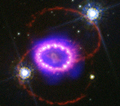Speaker
Dr
Tea Temim
(NASA Goddard Space Flight Center / ORAU)
Description
We present deep Chandra observations and Spitzer Space Telescope infrared (IR)
spectroscopy of the shell in the composite supernova remnant (SNR) Kes 75. The
remnant is composed of a central pulsar wind nebula (PWN) and a bright partial shell
in the South that is visible at radio, IR, and X-ray wavelengths. The X-ray emission
from the shell is dominated by a two-component thermal model with temperatures of
~0.2 and ~2 keV. While previous studies suggest that the hot component may originate
from reverse-shocked SN ejecta, our new analysis shows no definite evidence for
enhanced abundances. The IR spectrum of the shell is dominated by continuum emission
from dust with little, or no line emission. The X-ray and IR emission in the shell
are spatially correlated and the modeling of the IR spectrum shows that the dust is
heated to a temperature of ~ 140 K by a relatively dense, hot plasma. The total mass
of the hot dust component is 0.008 solar masses, while the dust-to-gas ratio in this
region is approximately the Galactic value, indicating that no significant dust
destruction has occurred in the shell. The comparison of the X-ray and IR data
suggests that the emission may originate from an interaction of the SN blast wave
with clumpy circumstellar medium (CSM).
Primary author
Dr
Tea Temim
(NASA Goddard Space Flight Center / ORAU)
Co-authors
Dr
Eli Dwek
(NASA Goddard Space Flight Center)
Dr
Patrick Slane
(Harvard-Smithsonian Center for Astrophysics)
Dr
Richard Arendt
(CRESST, University of Maryland-Baltimore County)

